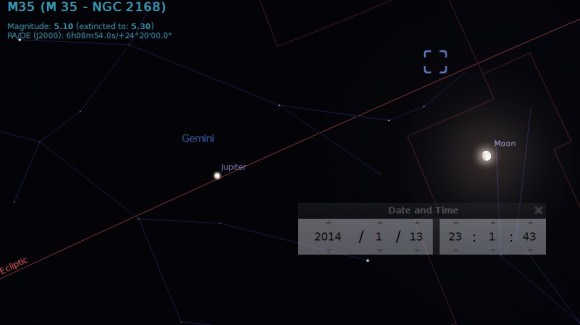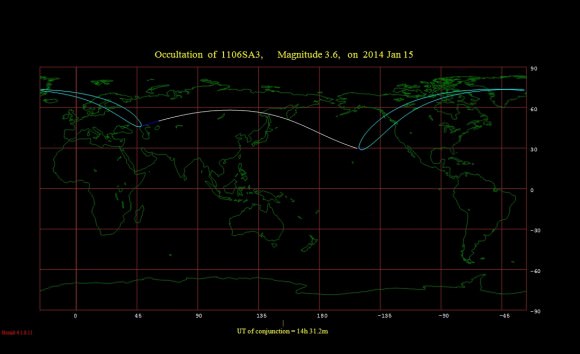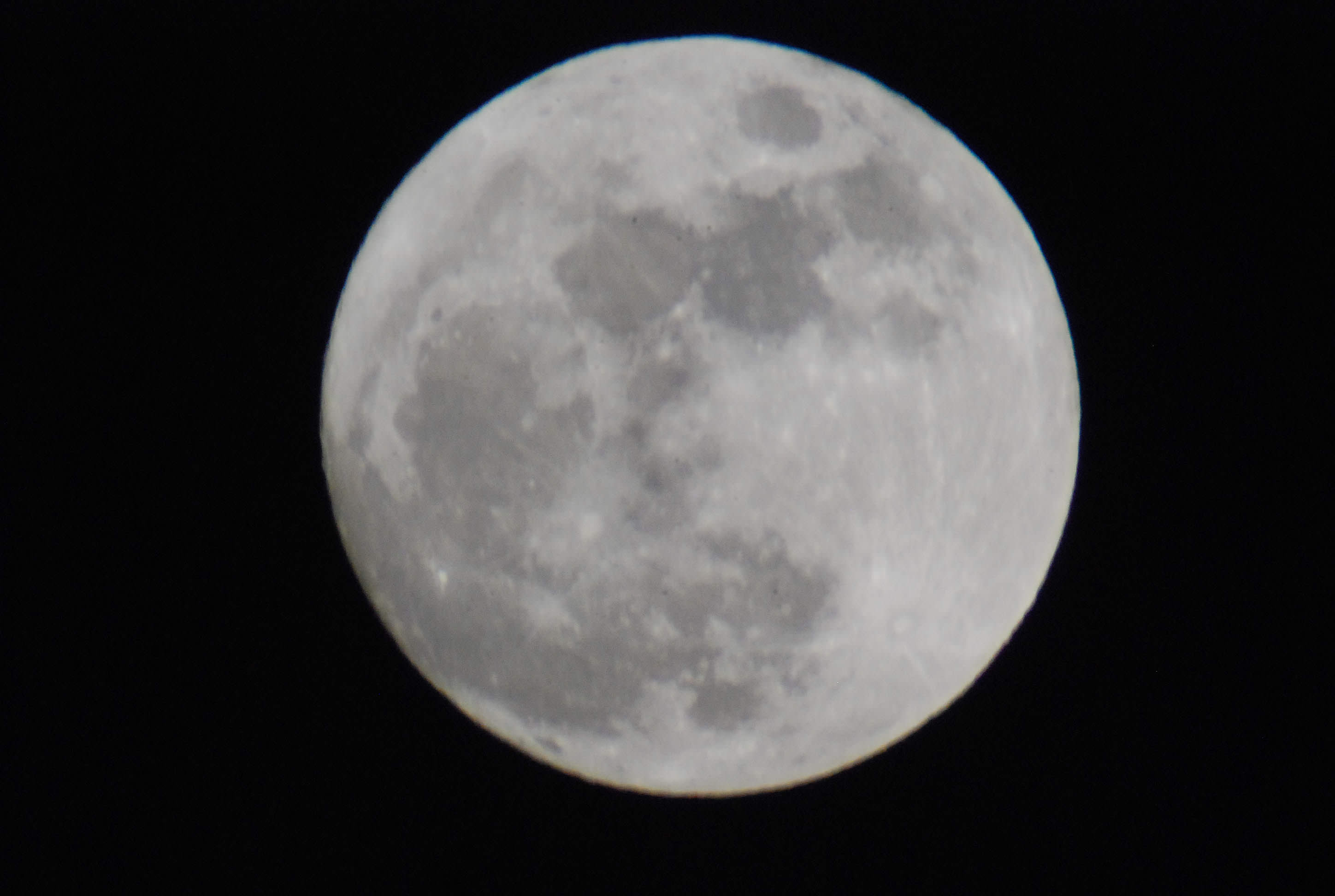Last month, (and last year) we wrote about the visually smallest Full Moon of 2013. Now, in a followup act, our natural satellite gives us an even more dramatic lesson in celestial mechanics with an encore performance just one lunation later with the smallest Full Moon of 2014.
We’ve noted the advent of the yearly Mini-Moon, a bizzaro twin to the often over-hyped “SuperMoon,” or Proxigean Full Moon. Occurring approximately six months apart, you can always expect lunar apogee to roughly coincide with the instant of a Full Moon about half a year after it coincides with perigee. In fact, the familiar synodic period that it takes the Moon to return to like phase (such as Full back to Full) of 29.5 days has a lesser known relative known as the anomalistic month, which is the period of time it takes the Moon to return to perigee at 27.55 days.
But the circumstances for “Mini-Moon 2014” are exceptional. The first Full Moon of the year occurs on the night of January 15th at 11:52 PM EST/4:52 Universal Time (on January 16th). This is just 2 hours and 59 minutes after the Moon reaches apogee at 406,536 kilometres distant at 8:53 PM EST/1:53 UT. This isn’t the farthest apogee that occurs in 2014, but it’s close: the Moon is just 32 kilometres more distant on July 28th, 2014. Apogee can vary from 404,000 to 406,700 kilometres, and this month’s apogee falls just 164 kilometres short of the maximum value.
As you can see, this year’s Mini-Moon falls extremely close to apogee… in fact, you have to go all the way back to the Full Moon of November 18th, 1994 to find a closer occurrence, and this year’s won’t be topped until May 13th, 2052! The Moon will appear only 29’ 23” in size on Wednesday night at moonrise, very close to its minimum possible value of 29’ 18”. This is also almost 5 arc minutes smaller than the largest “Super-Moon” possible.
Cool factoid: you actually move closer to the Moon as it rises, until it transits your local meridian and you begin moving away from it, all due to the Earth’s rotation. You can thus gain and lose a maximum of one Earth radii distance from the Moon in the span one night.
We also just passed the most northern Moon of 2014, as it reached a declination of 19 degrees 24’ north this morning at 8:00 UT/3:00 AM EST. This is a far cry from the maximum that can occur, at just over 28 degrees north. This is because we’re headed towards a “shallow year” as the Moon’s motion bottoms out relative to the ecliptic in 2015 and once again begins to widen out in its 18+ year cycle to its maximum in 2024-25.

This week’s Moon also visits some interesting celestial targets as well. The waxing gibbous Moon sits just 5.1 degrees south of the open cluster M35 tonight. Notice something odd about the Moon’s position Monday night? That’s because it is passing through Orion the Hunter, one of the six non-zodiacal constellations that it can be found in. Can you name the other five? Hint: one was the “13th sign of the zodiac that created a non-traversy a few years back.
On Tuesday evening, the Moon passes six degrees from the planet Jupiter. This presents a fine time to try and spot the planet in the daytime to the Moon’s upper left, just a few hours prior to sunset.
The Moon will also occult the +3.6 magnitude star Lambda Geminorum on January 15th for observers in northwestern North America. In fact, viewers along a line crossing central British Columbia will witness a spectacular graze along the lunar limb as the star winks out behind lunar mountains and pops into view as it shines through lunar valleys along the edge of the Moon. This can make for an amazing video capture, we’re just throwing that out there…

In addition to being this year’s Mini-Moon, the January Full Moon is also known as the Wolf Moon in the tradition of the Algonquin Native Americans, as January was a time of the mid-winter season when starving wolf packs would howl through the long cold night. The January Full Moon is also sometimes referred to as “The Moon after Yule,” marking the first Full Moon after Christmas.
And just when is the next Super Moon, you might ask? Well, 2014 has three Full Moons occurring within 24 hours of perigee starting on July 15th and finishing up on September 8th. But the most notable is on August 10th, when the Moon passes perigee just 27 minutes from Full. Expect it to be preceded by the usual lunacy that surrounds each annual “Super Moon” as we once again bravely battle the forces of woo and describe just exactly what a perigee Full Moon isn’t capable of. Yes, we still prefer the quixotic term “Proxigean Moon,” but there you go.
Also, be sure to wave a China’s Chang’e-3 lander and rover in the Bay of Rainbows (Sinus Iridum) as you check out this week’s Full Moon, as it just experienced its first lunar sunrise this past week.
Be sure to send those Mini-Moon pics and more in to Universe Today, and let’s get this week’s #MiniMoon trending on Twitter!


I got slightly different results for the time and distance for perigee from JPL’s Horizons web interface: Doing one minute displays of the distance from earth’s center to the moon’s center, Horizons gives the minimum distance of 406,533 km at 1:35 UT on January 16, 2014.
-Anthony Cook
Griffith Observatory
Thanks for the info… not surprising that different platforms yield slightly different times and distances. We’re drawing from Fourmilab’s handy Lunar Perigee & Apogee calculator:
http://www.fourmilab.ch/earthview/pacalc.html
Its probably a very slight factor in the motion of the Earth-Moon system that one (or both) systems aren’t accounting for.
Full Moon in Cancer
On January 15 the Moon in its sometimes moody home sign Cancer opposes the Sun in occasionally crusty Capricorn. This dramatic face-off between the two largest bodies in the sky represents a contrast between the sensitive, self-protective lunar needs of Cancer and the hard-nosed discipline and toughness of the solar transit in Capricorn. Both signs seek security, but the first one is about feelings, family and one’s private life while the second is concerned with professional and public matters.
Every Full Moon raises emotional tides as we’re challenged to address two seemingly opposing needs. However, the very nature of opposites is that they are intimately connected and can be seen as two sides of the same coin. While Caps may be stoic and Crabs a touch tender, one sign can support the other. What’s the use of being tough and making a mark in the world if we lack the sensitivity to appreciate the fruits of our labors? Capricorn without Cancer is like an empty suit that looks great on the rack but lacks the flesh and blood emotion needed to bring it to life. On the other hand, if we’re overly self-protective and allow fear of discomfort to dominate our thoughts and actions, we remain in an infantile state of df dependency that diminishes the likelihood of success.
Of course, it’s understandable to feel insecure in these uncertain times. Tense lunar aspects with disruptive Uranus and Pluto on the 14th add to the sense that the world is out of control. Reacting to these pressures often provokes a Cancerian desire to stay within the protective shell of familiar people, beliefs and behavior. Or, for more ambitious individuals, to turn insecurity outward like a Capricorn general who is more inclined to seek new territory to conquer than to fully appreciate the garden he already possesses.
In some ways, the meaning of this lunation is to open a wider channel of communication between the child and adult parts of ourselves. The Cancer Moon recognizes that we all can use some tender, loving care but that without balancing them with goals, commitment and a strong sense of purpose we never grow up. The Capricorn Sun demands that we are productive, yet without allowing some time for relaxation and pleasure we grow cold and rigid.
The good news, though, is that we don’t have to choose between these extremes. Like every Full Moon, this one is a reminder to put our lives into motion. When we are able to shift from tender to tough and back again we experience both sides of the equation. It’s a message of wholeness, a lesson in overcoming the instinct to polarize and act as if we’re limited to a single way to take care of ourselves and those we love. Mobility provides us with access to a full range of experience that increases our chances of taking the progress we make in the world and bringing it back home to warm our hearts and hearths. It allows us to blend vulnerability with ambition so that we take charge of our lives and create a richer experience that makes our hard work worth the effort.
I am a Virgo with Cancer Rising (August 27, 1956 1:51 AM Houston, Texas USA ww.mayorgalvan.com
I suppose global warming is to blame for this, too… 😉